TA SOM (1181 - 1220)
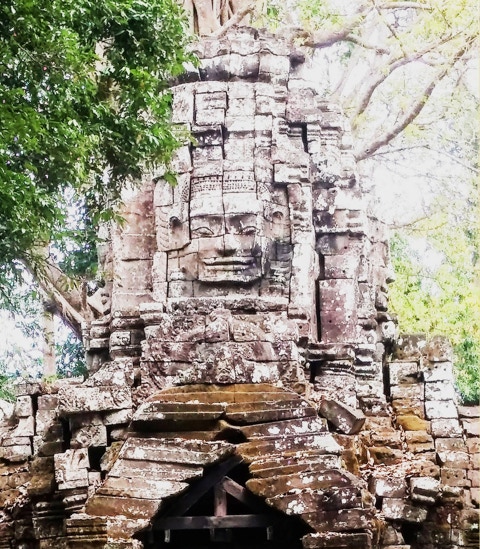
TA SOM (1181 - 1220)

3RD WEST GOPURA, TA SOM (1181 - 1220)
As a "forest monastery," Ta Som was built on the extreme periphery of the contiguous network of temples which constituted Angkor. (The role of the "forest monk" in Hinduism and Buddhism is described in Appendix VII to this collection's introduction.) The temple's intimate scale and comparatively inaccessible site reflects the goal of a life free of public ceremonies and duties, such as those enumerated on Preah Khan's dedicatory stele, so the monks, resident or itinerant, could concentrate on their own pursuit of salvation. This "face tower" on the temple's 2nd west gopura (A) is the first thing a visitor sees approaching the temple from Preah Khan and Angkor Thom. Yet it is no more self-explanatory than the ones above the 4th east gopura at Banteay Kdei, the five gates to Angkor Thom or the dozens meditating over the 3rd terrace of the Bayon. The identification of these towers with Avalokitesvara (Kh. > Lokesvara,) the "bodhisattva of compassion," is largely based on Preah Khan's dedication to him and Jayavarman VII's association of him with the posthumous form of his father and, it would appear, himself. His presence at that king's other monastic temples, Ta Prohm, Ta Som and Banteay Kdei and Neak Pean, the closest temple to Ta Som set in the middle of the Jayatataka Baray, has seemed to strengthen this hypothesis.
The need to give these face towers a fixed identity may, however, be contrary to the nature of these monasteries because they would inevitably be projections or objectification of the monk’s own mind and illusory sense of an independently generated self. These temples were not built to worship a god but as places for monks to contemplate the unity of all perceptions and ideas as dependently-generated emanations of one, non-manifest, “subtle,” “empty” and apophatic "god-head" or absolute. Thus the "inscrutability" of the "face towers" and what they express may be precisely their point. Whatever that may represent, their widely dispersed locations link them – and Angkor – to the secret behind their smiles: that, in some sense they do not exist and, at the same time, exist everywhere. A brief overview of leading theories concerning the identity of the "face towers" concludes section XIV analyzing the Bayon in the introduction to this anthology.
AN ISLAND IN THE SAND
Ta Som originally had three enclosures with a moat running between the 2nd and 3rd. The 2nd enclosure has two cruciform gopuras (A, D) on its east and west, both "face towers," the western one pictured above. Both have porches only on the north and south joining them to the enclosure wall which has neither north nor south gopuras. In contrast, the 1st east and west cruciform gopuras have four porches and are of equal size with the central shrine (B;) might they have held some cult image despite their primary function as a gate or passage? The temple's site plan lacks the irregularities and sense of incompletion of Ta Nei’s because completion, at least in the sense of any axial continuity across its 1st or 2nd enclosures, seems deliberately eschewed.
The usual westward linear extension or offset between the 1st east gopura and shrine (B) is evidenced only by a gap attributable to the now canonical libraries. The objective at Banteay Samre, realized at Ta Prohm and its two successor monasteries, of an unbroken enfilade across the east-west axis (D to A) seems to have been forgotten. These caesurae are magnified by the 1st east and west gopuras’ west and east porches reaching out into a void, the west gopura unconnected to the sanctuary’s (B) west porch just a few feet away. Similarly, the cruciform chambers of the north and south gopuras project so closely to the central shrine that their inner arms were not a symmetrical (that is, shorter than their outer ones) they would touch the shrine; but they have been deliberately truncated without even a paved terrace between them and the shrine. The central shrine’s isolation, like an island in its enclosure, can, therefore, be attributed to premeditation
SITE PLAN, TA SOM (1181 - 1220)
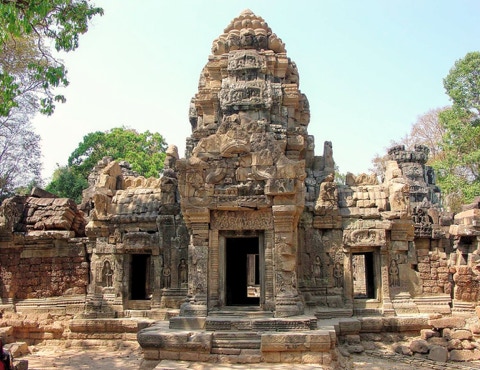
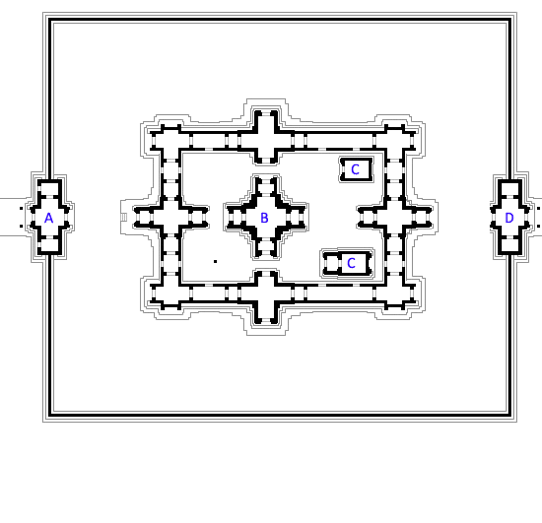
1ST EAST GOPURA, TA SOM (1181-1220)
The cruciform 1st west gopuras' north and south porches (photo above) abut short, fenestrated galleries linking them to the cruciform north and south corner blocks of the 1st enclosure’s gallery. These are joined by longer blind (unbroken by doors or windows) galleries stretching to the 1st north and south, cruciform gopuras and beyond to the southeast and northeast corner blocks. So the 1st enclosure closes itself off from the external world as much as possible like an inward-facing cloister. On its interior, three doors on both the north and south ranges as well as the gopuras, open out onto the unpaved, sand-covered “quad” or garth, providing the resident monks four axial and six oblique approaches from these galleries to the central shrine (B) and the two libraries (C.) This introspective space within the enclosure could be interpreted as “unmapped,” non-hierarchical and fluid, in contrast with Hindu shrines or more formal Buddhist monasteries where a liturgical path is clearly prescribed and demarcated by preparatory stages for approaching the garbagriha. At Ta Som each monk seems to have been responsible for finding his own way across the courtyard, to the shrine, the libraries or other monks’ cells. The absence of such distinctions and boundary markers probably means the laity were not allowed into this enclosure and only ordained bhikkhu had access to it.
A comparison, however, distant, not to say far-fetched, might be made between this “island” shrine or presat (B,) representing Mt. Meru and the attainment of enlightenment, and the rocks in a sea of gravel in a Japanese karesansui (a Zen dry, landscape garden,) such as the celebrated ensemble at Ryoan-ji. Monks there passed a life-time meditating from its veranda on fifteen rocks crossing the ocean of consciousness, as it washes away the maya of self and other, their minds swimming towards a goal which is necessarily invisible and incomprehensible, The Chinese emissary, Zhou Duguan, chose the same metaphor to describe the island shrine at the following temple in this catalog, Neak Pean. At Ta Som, monks mat have earned entry to the 1st enclosure and shrine, though their objective could not be reached in a world of dimension or locations. It has often been observed that every Khmer temple is incomplete, perhaps to express a similar unbridgeable gap between merely human conception and the inconceivable divine. If so, Ta Som is unusually obvious about this, since the only asymmetry in the temple is the porch quite intentionally omitted from the northern library (C.)
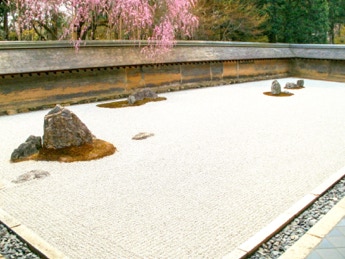
KARESANSUI, RYOAN-JI, KYOTO (1450)
BEFORE A PEDIMENT . . .
H
PEDIMENT, 1ST ENCLOSURE, TA SOM (1181-1220)
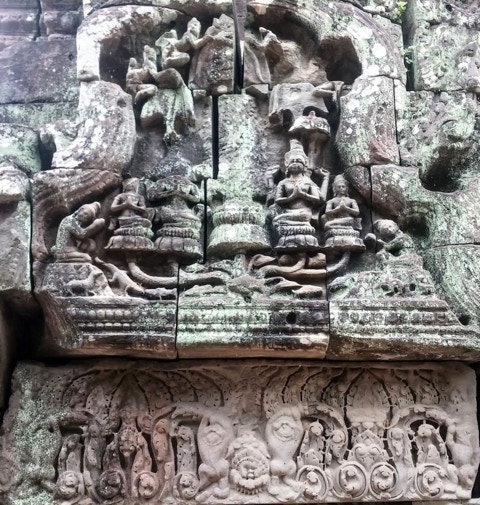
Jayavarman VIII's (1243-1295) campaign to erase every vestige of his predecessor's Buddhist faith reached even to Ta Som's isolation. This defaced pediment must therefore have held a Buddhist image which in light of its connection with the complex of temples around the Jayatataka Baray might well have represented the Mahayana bodhisattva of compassion, Avalokitesvara, the dedicatee of Preah Khan and Neak Pean. The central figure sits on a lily pad, the symbol of enlightenment rising through the polluted waters of samsaric blindness into the clear sunlight of dharma, the divine wisdom that reality begins when the phantoms which muddy the mind are finally clarified as empty. The lotus or padma was especially associated with Avalokitesvara, also known as Padmapani, "he who holds the lotus in his hand," and the earliest text mentioning this bodhisattva is, appropriately, The Lotus Sutra which enumerates no fewer than thirty-three of his manifestations.
Four of these are presumably represented on this pediment to his right and left, each on his own lotus pad growing out of the common stem of his wisdom or nature: Tara, Hayagriva, Sudhanakumara and Bhrikuti (a form of Tara) are all possibilities. Two mortals worship the emanations from either shore of the lotus pond, looking on like the monks at Ryona-ji, while apsaras shelter the five figures with parasols of honor. This arrangement of four figures around a fifth is found not only in the quincunxes of Khmer "temple mountains" but many Buddhist mandalas, where the four are emanations, aspects or manifestations, of the central "Buddha nature" or tathagata, here presumably compassion, love, symbolized by padmas. One of the most prized occult sadhanas imparted by Vajrayana guru masters to novices was visualization of a personal yidam or bodhisattva venerated by that guru’s lineage by imagining four or his manifestations around him, then repeating the process for each, until they were surrounded by quincunxes, articulating more fully the yidam's nature. Upon realizing these were simply visualizations of a common non-manifest essence or Buddha wisdom, associated with the dharmakaya, the occult (occluded, “subtle”) form of the "Buddha body," they would collapse the mandala and with it themselves into non-existence. The use of a yidam is discussed in Section XIII, under the heading "Vajrayana Mandala Visualization" and in connection with the "face towers" at the Bayon in section XIV. "A Vajrayana Anti-Architecture?"
The lintel above shows an especially unintimidating kala (time, dissolution) between two kneeling figures who rather rudely turn their naked backsides towards the viewer and hold the garland traditionally issuing from the mouth of a kirtimukha, amongst which two siddhas, Hindu or Buddhist sages who are “accomplished,” who have attained siddhis, supernatural powers, perhaps "forest monks," sit in niches among the foliage, as in the frieze at Preah Khan. The two figures turned away from us seem sub-human and could be leogryphs, monkeys or asuras, but, given the temple’s proximity to the battle site and their distinctive, Cham flower basket helmets, one suspects they represent the Khmers’ defeated foe. In an orthodox Buddhist interpretation, they would be servants of Mara, the demonic source of samsaric illusions distracting monks with their seductive appearances which masked the vile nature behind them. In this, they resemble Duessa and the Red Cross Knight in Spenser's Faerie Queene (1590,) herself an allegorical "type" of Eve, like Pandora, Morgan la Faye, Kundry. et al. Are the two here apotropaic like a kirtimukha, warding off their own evil, except here the evil is their deceptive faces or false “fronts?” By turning their backs and not engaging the viewers’ gaze, do they prevent them from believing they represent reality, perhaps warning them that all images, however sacred, including this pediment, are mental projections of a nirguna, (quality-less, unconditioned,) niskala,(hidden, non-manifest) truth not before their eyes but behind them? Is that truth behind the viewer looking up at the pediment, occluded by himself? If so, the pediment would be seen more rigorously iconoclastic than the Hindu zealot, Jayavarman VIII, who attempted to erase it.
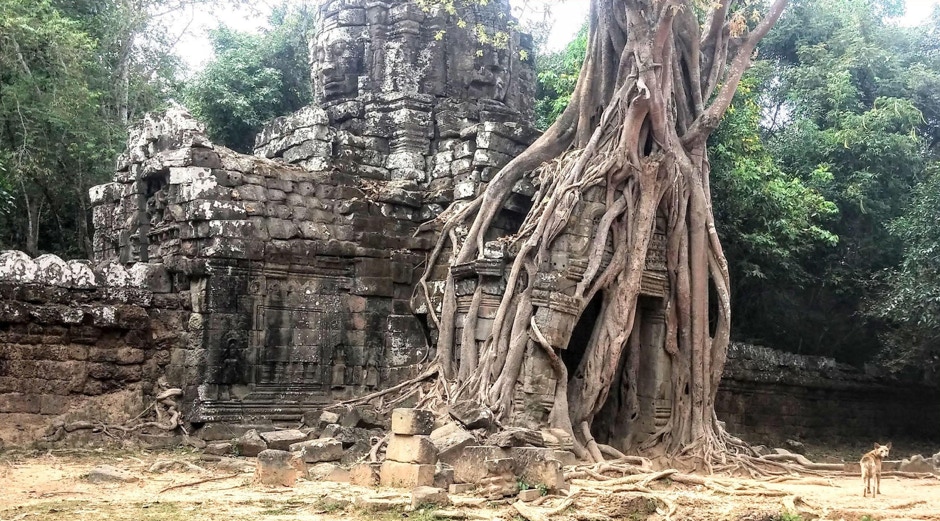
2ND EAST GOPURA, TA SOM (1181 - 1220)
The principle entrance to Ta Som, like most Khmer temples, is from the east, in this case, appropriately, from out of the forest, rather than from the road along the Jayatataka Baray to Preah Khan and Angkor Thom beyond. The 2nd east gopura (D) has for obvious reasons become the iconic image of the temple; a strangler fig, ficus religiosa, is slowly crunching the gopura's eastern porch between its roots, though it has yet to invade its cruciform, central chamber. The usual repeated aedicular tiers of a Khmer shrine module are here replaced by four faces crowned by a traditional amalaka, lotus blossom. The faces are not contained inside a shrine or gala recess rather they emerge directly from the prasat’s square central core in front of the plane of the tower’s central projection. They wear an incised wreath around their high foreheads while earrings drip from their enlarged earlobes, marking their high social station. This is not just "aedicular emergence" but submergence of the aedicule, inverting the relationship between the shrine and its supposed occupant; the face has incorporated the tower of which it is a part, as effectively as the strangler fig its porch. The shikhara’s center is transformed so it can be read as the inside of the faces’ heads. Similarly, the viewers expecting to look into a framed portal, instead find that the frame has become a face, not looking at them, not looking out at all, but inward and drawing them ineluctably with it. The Hindu iconography of Mt. Meru with its aedicular tiers lined with gods and their palaces or shrines, has been replaced at this Buddhist shrine by a head or rather state of consciousness, which "sees through," ignores and absorbs the dimensions of architectural space. The faces' supreme indifference to the destruction of the straggler figs next to them no doubt results from their having achieved sunyata, the awareness that "form is emptiness" and mind, illusion. Thus, it would not be demeaning but accurate to describe the faces as "empty-heads."
72